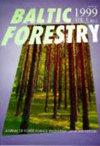Evaluation of properties of graded density fiberboard produced from wood residues (sawdust and corrugated paper)
IF 0.6
4区 农林科学
Q3 FORESTRY
引用次数: 2
Abstract
Reuse of materials from industrial and services waste streams is pertinent to achieving sustainable forest production. The enormous wood residues generated at sawmill and the disposal of wood-based products poses threat not only to sustenance of the forest resources but also has negative adverse effect on the environment. Limitation exists in the utilization of wood residues as raw material for panel board production in developing countries. This study examined the physical and mechanical properties of graded density fibreboards produced from varying mixture of sawdust and corrugated paper (pulp) at the Forestry Research Institute of Nigeria (FRIN) in 2019. A 2×9 factorial experiment in one-way analysis of variance was used to test for significant difference between the factors (density and mixing ratio) considered. The results showed that densities of all boards produced varied relating to mixing proportions. The densities increased with increasing content of corrugated paper. Boards produced at 0.45 g/cm3 showed higher density (0.648 g/cm3), bending strength (MOR) (1.47 N/mm2) and lesser water absorption (118.69%) than those produced at 0.65 g/cm3 having values of 0.58 g/cm3, 1.32 N/mm2 and 153.67%, respectively. However, boards produced at 0.65 g/cm3 had higher elasticity in bending (MOE) (209.19 N/mm2) and lesser thickness swelling (6.29%) than those produced at 0.45 g/cm3 having values of 74.87 N/ mm2 and 10.88%, respectively. Panels G (mixing ratio = sawdust : corrugated paper : urea formaldehyde = 20 : 60 : 20), E (30 : 50 : 20) and I (0 : 70 : 20) showed superior features in physical and mechanical properties comparing with panel I being the best mixture. Conclusively, wood residues (sawdust and corrugated paper) are suitable raw materials for fibreboard production.用木屑和瓦楞纸板生产的分级密度纤维板的性能评价
工业和服务业废物流中材料的再利用与实现可持续森林生产有关。锯木厂产生的大量木材残渣和木制品的处置不仅对森林资源的维持构成威胁,而且对环境也产生了负面影响。在发展中国家,木材残留物作为板材生产原料的利用存在限制。该研究于2019年在尼日利亚林业研究所(FRIN)研究了由锯末和瓦楞纸(纸浆)的不同混合物生产的分级密度纤维板的物理和机械性能。采用单向方差分析中的2×9析因实验检验所考虑的因素(密度和混合比)之间是否存在显著性差异。结果表明,不同混合比例的板料密度不同。密度随瓦楞纸含量的增加而增加。0.45 g/cm3生产的板材密度(0.648 g/cm3)、抗弯强度(MOR) (1.47 N/mm2)和吸水率(118.69%)分别高于0.65 g/cm3生产的板材(0.58 g/cm3、1.32 N/mm2和153.67%)。然而,与0.45 g/cm3生产的板材(74.87 N/mm2和10.88%)相比,0.65 g/cm3生产的板材具有更高的弯曲弹性(MOE) (209.19 N/mm2)和较小的厚度膨胀(6.29%)。板材G(混合比例=锯末:瓦楞纸:脲醛= 20:60:20)、板材E(30:50:20)和板材I(30:70: 20)在物理力学性能方面表现出优异的性能,其中板材I为最佳混合物。最后,木材残留物(锯末和瓦楞纸)是生产纤维板的合适原料。
本文章由计算机程序翻译,如有差异,请以英文原文为准。
求助全文
约1分钟内获得全文
求助全文
来源期刊

Baltic Forestry
农林科学-林学
CiteScore
1.60
自引率
0.00%
发文量
23
审稿时长
>12 weeks
期刊介绍:
The journal welcomes the original articles as well as short reports, review papers on forestry and forest science throughout the Baltic Sea region and elsewhere in the area of boreal and temperate forests. The Baltic Sea region is rather unique through its intrinsic environment and distinguished geographical and social conditions. A temperate climate, transitional and continental, has influenced formation of the mixed coniferous and deciduous stands of high productivity and biological diversity. The forest science has been affected by the ideas from both the East and West.
In 1995, Forest Research Institutes and Universities from Estonia, Latvia and Lithuania
joined their efforts to publish BALTIC FORESTRY.
 求助内容:
求助内容: 应助结果提醒方式:
应助结果提醒方式:


